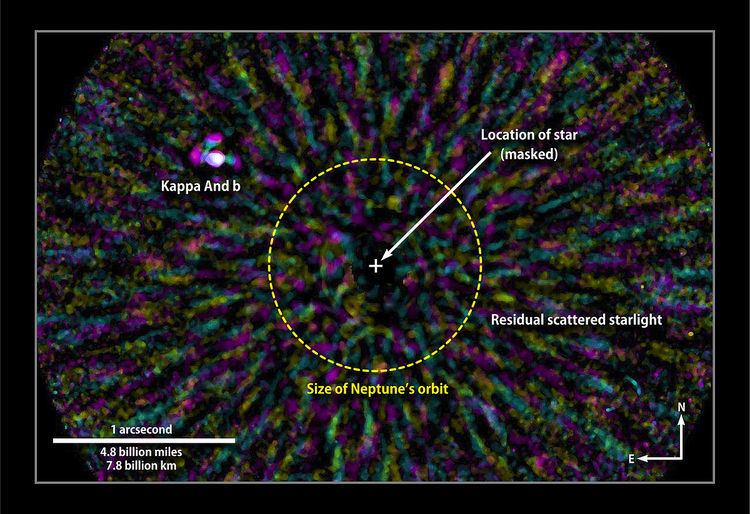 | ||
Kappa Andromedae b is a substellar object and massive planet or brown dwarf orbiting Kappa Andromedae, a star in the Andromeda constellation, about 170 light years away. The object, nearly 13 times the mass of Jupiter, was directly photographed by the Subaru Telescope. There has been considerable debate as to whether Kappa Andromedae b is an exoplanet or a brown dwarf; and, until the question can be clarified, scientists have dubbed it the "Super-Jupiter" object.
Contents
Discovery
Through the Strategic Explorations of Exoplanets and Disks with Subaru (SEEDS) survey, the Subaru Telescope, located atop Mauna Kea, Hawaii, astronomers were able to photograph Kappa Andromedae b by taking a near-infrared photograph of the parent star and processing it to reduce its light. Between January and July 2012, Subaru observed Kappa Andromedae using four separate infrared wavelengths, and when comparing photographs from January and July, the team of astronomers was able to determine that Kappa Andromedae and Kappa Andromedae b were gravitationally bound.
Through those photographs and other research by the Subaru team, a few details about the "Super-Jupiter" object have been revealed. The object's mass has been calculated as approximately 12.8 times Jupiter's mass, the host star's mass as 2.4 to 2.5 solar masses. The temperature of the object is estimated to be around 1700 kelvin, and, if seen up close, would appear reddish in color. The object's distance from its parent star is about 1.8 times Neptune's distance from the Sun.
Planet or brown dwarf?
It is unclear whether Kappa Andromedae b is a gas giant or a brown dwarf—that is, an object massive enough to fuse deuterium but not hydrogen-1. Conventional planetary formation models dictate that the lowest expected mass for a brown dwarf is around 13 times that of Jupiter. Kappa Andromedae b has a mass of about 12.8 times that of Jupiter, apparently too small to fuse deuterium in its core; however, according to NASA discovery team member Michael McElwain, "this isn't definitive, and other considerations could nudge the object across the line into brown dwarf territory." Analysis of the object's brightness reveals infrared colors similar to those found for other massive imaged planets like beta Pictoris b, further suggesting that Kappa Andromedae b could be a planet rather than a more massive brown dwarf.
The primary uncertainty in classifying Kappa Andromedae b is the age of the primary star. In the original discovery paper, Kappa Andromedae was estimated to have an age between 20 and 50 million years based on its similar kinematics to and apparent membership in the Columba association. Optical photometry of the star is consistent with that for stars with these ages as well as those slightly older (up to about 120 million years). Using planet evolutionary models to map between the object's brightness and mass at a given age, a 20- to 50-million-year-old companion with Kappa Andromedae's properties would have a mass between about 11.8 to 14.8 Jupiter masses.
Other properties of the host star may point to an older age, specifically its position on the Hertzsprung-Russell diagram and its surface gravity compared to predictions for stars with a range of ages. These comparisons imply an older age of 220±100 years and in turn a mass of 50+16
−13 Jupiter masses, easily within the brown dwarf mass regime, not planet regime. Both age estimates may have significant uncertainties. While Kappa Andromedae has been identified as a Columba member, its galactic coordinates may be outliers compared most Columba members, although they are quite similar to those for HR 8799. Evolutionary models may systematically overestimate the ages of stars like Kappa Andromedae.
Significance
The discovery of Kappa Andromedae b has impacted current stellar theory. Astrophysicists have been unsure about the maximum size for a star that can harbor objects created from a protoplanetary disk. This discovery confirms that stars that do so can be at least as massive as Kappa Andromedae, which is about 2.5 times the sun's mass. If Kappa Andromedae b proves to be an exoplanet, it will be one of the very few that have been directly imaged thus far.
